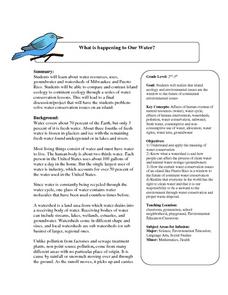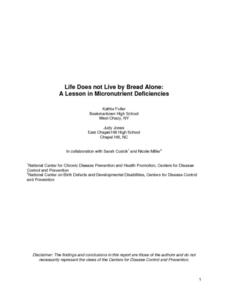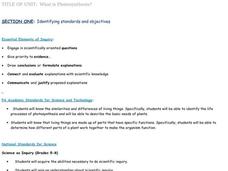Curated OER
Paper, Microorganisms, and Biocides
Students study the paper making process and discuss the implications of recycling paper. Students conduct a lab to determine if microorganisms are present in different solutions used in the papermaking process today.
Curated OER
Field Experiments on Succession
Student develop a hypothesis regarding the effects of either mowing or fertilizer upon the diversity of plant species in a grassland ecosystem. They set up experiment field plots and measure species richness.
Curated OER
Biodiversity: El Imposible National Park, El Salvador
Fifth graders explore the concept of how the more diverse an ecosystem is, the more interdependence of species exists within that system. The complex relationships among diverse species are difficult to identify. As species disappear or...
Curated OER
Comparison of Different Methods for Determining Stream Flow at a Stream Site
Students make measurements and calculations to determine the stream flow of an outdoor stream site. For this stream characteristics lesson, students travel to a field site to construct a transect across a stream and measure the...
Curated OER
Salt, Soil and Seeds
Learners investigate seed growth by experimenting with different soils. In this ecology activity, students plant seeds in paper cups and add differing amounts of salt to enhance the growth process. Learners record which...
Curated OER
Ecology - Ecosystem
Third graders research ecosystems, the work of ecologists, John Muir's contribution to the environment and an endangered species of their choice. They read books, participate in discussions, and write reports.
Curated OER
Ecology: Trees
Fourth graders research and identify the different layers of the forest. As a class, they observe real-life trees or analyze a poster, and discuss the characteristics of each forest layer. Students then draw a forest and label the...
Curated OER
Insect Biology and Ecology: A Primer
Students explore insects and closely related organisms. They examine the growth and development of a lady beetle. Students classify insects and organize them. They investigate pest management.
Curated OER
Powdery Mildew Fungi: Classification and Ecology
Students use a written key or illustrated key to identify fungi on plant leaves into its genus based on sexual or asexual reproduction, host range diversity, and host-parasite relationships.
Curated OER
Fire Ecology
Fourth graders examine the role fire plays in maintaining the physical factors of the scrub ecosystem. They see that world ecosystems are shaped by physical factors that limit their productivity.
Curated OER
Forest Food Web Activity
Students gain knowledge of food webs and ecological interconnections in the forest, and place different life forms in their proper place in a food chain. Students appreciate the balance of nature and how humans are affected by extinct...
Curated OER
Horticulture Crops in the agro-ecosystem
Ninth graders apply ecological analysis to fruit and vegetable production systems. In this horticulture lesson students learn about different management practices.
Curated OER
Populations and Ecosystems
Sixth graders examine the factors that influence the stability of ecosystems. They construct a miniature ecosystem in a jar that includes plants, small fish, and snails, record the population changes over a period of four weeks, and...
Curated OER
Ecologist's Activities
Students construct a model of a biome. In this ecology lesson, students use a shoebox, magazine pictures, paper, and string to create a model biome. Students glue the photos inside the shoe box and draw other objects, such as plants,...
Curated OER
What is Happening to Our Water?
Students compare and contrast Wisconsin's water resources to that of Puerto Rico. They research books about islands, particularly the Puerto Rican islands. Student view illustrations of island ecology. They discuss the illustrations and...
Curated OER
The Young Virginia Gardener: Windowsill Gardening-Starting the Garden
In this gardening worksheet, students choose 5 plants from a given list to include in their windowsill garden then read about how to start the garden and answer questions related to keeping it healthy.
Curated OER
Temperate Forests vs. Wetlands
Learners compare and contrast the temperate forest and wetlands by researching them in groups. In this forest lesson plan, students identify the economic, ecological, and social benefits of each.
Curated OER
Rainforest Vocabulary Words: Week 1
In these rainforest vocabulary worksheets, read the definitions and the matching terms for the following rainforest vocabulary terms: decomposers, deforestation, epiphytes, extinct, environment, pollute, vegetation, ecology, climate,...
Curated OER
Pollution Vocabulary
In this pollution vocabulary worksheet, students define the terms ecology, conservation, recycling, chemicals, endangered species, and valuable. Students then use the words to complete the sentences about pollution.
Curated OER
Life Does Not Live By Bread Alone
High schoolers investigate the relationship between micronutrients and proper metabolic function. The lesson should serve as an introduction to the subject. The subject of the function includes the study of plants, animals, and humans....
Curated OER
Countdown Calendar
Students create a calendar of endangered species. In this preservation lesson plan, students research endangered species of plants and animals around the Lake Pontchartrain Basin. Students gather facts about the endangered species and...
Curated OER
What is Photosynthesis?
Students investigate the similarities and differences of living things. Specifically, students will be able to identify the life processes of photosynthesis and describe the basic needs of plants.
Curated OER
Food Chains
Students investigate the food chain. In this ecology lesson, students define producers and consumers. Students use organism cards to demonstrate how the food chain works.
Curated OER
Watersheds and Wetlands Lesson Plan
Students study the characteristics of wetlands and watersheds. In this wetlands and watersheds lesson, students study the characteristics of wetlands. They investigate the plants and animals that live there and will tell the reasons...

























